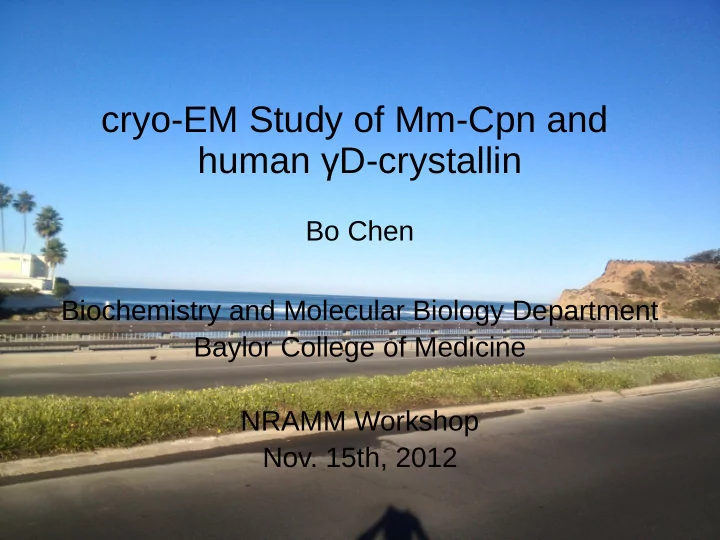

cryo-EM Study of Mm-Cpn and human γD-crystallin Bo Chen Biochemistry and Molecular Biology Department Baylor College of Medicine NRAMM Workshop Nov. 15th, 2012
Protein Folding Machines • Cells employs a cassette of chaperones to assist protein folding Hsp40, Hsp60, Hsp70, Hsp90, Hsp100 • Hsp60 family is also called chaperonin. • Chaperonin family is divided into type I and type II. Bacterial GroEL Type I Mitochondria Hsp60 Chloroplast Hsp60 Chaperonin Archaea Thermosome Type II Archaea Mm-Cpn Eukaryotic TRiC/CCT
Protein Folding Machines • Cells employs a cassette of chaperones to assist protein folding Hsp40, Hsp60, Hsp70, Hsp90, Hsp100 • Hsp60 family is also called chaperonin. • Chaperonin family is divided into type I and type II. Bacterial GroEL-ES Type I Mitochondria Hsp60 Chloroplast Hsp60 Chaperonin Archaea Thermosome Type II Archaea Mm-Cpn Eukaryotic TRiC/CCT
Cryo-EM Structures of Mm-cpn Post ATP-hydrolysis Transition ( ∆ lid) ATP-free (Using ATP/AlFx) ( ∆ lid) 8.0 Å 4.7 Å Zhang et al Nature (2010
HγD-crystallin : substrate of Mm-Cpn • A 20 kDa protein with two domains • Is essential for maintaining lens transparency • Aggregation of misfolded HγD-crysallin is responsible for the onset of cataract • Aggregation can be suppressed by Mm-Cpn • Refolding can occur with Mm-Cpn and ATP
Experimental Conditions • Specimens o Apo Mm-Cpn+GuHCl o Mm-Cpn + GuHCl denatured HγD-crystallin • Imaging of Mm-Cpn &HγD-crystallin Sample o 3200FSC electron microscope o 300 kV o Gatan 10k CCD camera o 2.0 Å/pixel (detector magnification of 89,000x) o Defocus range: 2.0um ~ 3.5um • Data Processing o EMAN1
cryo-EM raw image of Cpn-hγD sample @ 3200FSC 500 Å
Reference free 2D class averages of Mm-Cpn & HγD- crystallin sample 100 90 Percentage(%) 80 70 End-on 60 View 50 Side 40 View 30 20 10 0 Mm-Cpn only
Multiple Reaction Products May Exist in Mm-Cpn & HγD-crystallin Sample
Unsupervised Multiple Model Refinement Process C8-Symmetry Subset I (52%) Noise I-added C8- Initial Model symmetry Imposed C8-Symmetry Model by EMAN1 Subset II Initial model (33%) Noise II-added Initial model Particle Sets (~100,000 particles, C8-Symmetry defocus range: 1.5- Subset III 3.5 µµ) (15%) Noise III-added Initial model Initial Model + Random Noise
Subset I Model Resembles Apo State Mm-Cpn T op View Bottom Side View View Subset I (52%) T op View Bottom Side View View Lidless Mm- Cpn (Zhang, Nature, 2010)
Refined Map of Subset II Shows One-ring Less Open and One-ring Open Conformation T op View Bottom Side View View Subset II (33%) T op View Bottom Side View View Lidless Mm- Cpn (Zhang, Nature, 2010)
Symmetry-Free Reconstructions of 2 Subsets T op View of Apical T op View of Apical Domain Domain Subset I Subset II (30,000 (23,421 ptcls) particles) Bottom View of Apical Bottom View of Apical Domain Domain
Conclusions • ~50% of particles of Mm-cpn + denatured HγD-crystallin (Subset I) correspond to Apo state Mm-Cpn. • ~33% of complex in the Mm-Cpn + denatured HγD-crystallin (Subset II) has one ring entirely open and another ring less open. • Symmetry free reconstruction shows additional density in the apical region in one subunit of one ring with a break-down of 8 fold symmetry (subset II). • The observed protruding density may correspond to part of the HγD-crystallin
Future Directions • Cryo-EM Biochemical gold labeling of HγD-crystallin
Acknowledgement Joanita Jakana, Previous NCMI Members: BCM Junjie Zhang Yao Cong Junjie Zhang, BCM Ge (Jerry) Zhang Guang (Grant) T ang Steve Ludtke, Dan Goulet, MIT BCM Current NCMI Members: Kelly Knee, MIT Joanita Jakana Dr. Wah Chiu, Oksana Sergeeva, MIT Jesus Galaz Montoya BCM Boxue Ma Dr. Jonathan King, Ming Cheng MIT Htet Khant Caroline Fu All the NCMI personals Funding Resources Center for Protein Folding Machinery and National Institutes of Health Roadmap-supported Nanomedicine Development Center.
Backup Slides
Unfolding/Misfolding of HγD-crystallin Causes Onset of Cataracts Jonathan King lab homepage, http://web.mit.edu/king- lab/www/
Mm-Cpn Suppresses HγD-crystallin Aggregation HγD- H γ D-crystallin alone Aggregation Level Mm-Cpn+HγD- crystallin Knee et al, Protein Science, 2011
Differences is Observed Between Subclass I & II 2D Side Views 2D class averages of subset I 2D class averages of subset II
Statistical Analysis of 2D Class Averages in Subset I and II 2D Class Averages Associated with Angular Projections of C8-symmetry Imposed Refinement Map T Subset I B Subset II 2D class Averages
2D Class Averages Statistical Analysis Results 2D Class Averages Associated with 2D Class Averages Associated with Angular Projections of C8- Angular Projections of C8-symmetry symmetry Imposed Refinement Imposed Refinement Map Map Apo Mm- Subset I Cpn control Subset II Apo Mm- Cpn control
5/10 Subclasses (49%) Particles Show Double-ring Open Conformation T op Botto m Side
5/10 Subclasses (51%) Particles Show One-ring Open One-ring Closed Conformation
Continuous Density is Observed on the Apical Region of Top Ring in Subset II but not Subset I Subset I Subset II
Recommend
More recommend